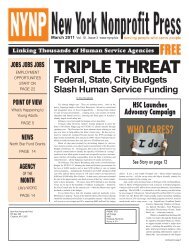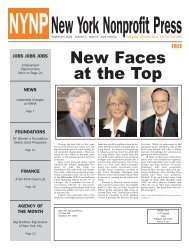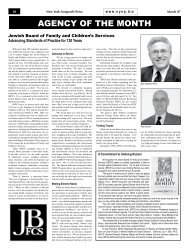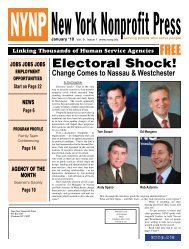Anderson Center for Autism - New York Nonprofit Press
Anderson Center for Autism - New York Nonprofit Press
Anderson Center for Autism - New York Nonprofit Press
You also want an ePaper? Increase the reach of your titles
YUMPU automatically turns print PDFs into web optimized ePapers that Google loves.
12 <strong>New</strong> <strong>York</strong> <strong>Nonprofit</strong> <strong>Press</strong> www.nynp.biz September 2012<br />
agency of the Month<br />
<strong>Anderson</strong> <strong>Center</strong> <strong>for</strong> <strong>Autism</strong><br />
A Focus on LifeLong Learning<br />
by Fred Scaglione<br />
In 2001, <strong>Anderson</strong> <strong>Center</strong> <strong>for</strong> <strong>Autism</strong> in<br />
Staatsburg effectively began the new millennium<br />
with a new name, a new Executive Director<br />
and a new focus on providing specialized services<br />
<strong>for</strong> a targeted group of consumers. Initially<br />
founded in 1924 by Dr. Victor <strong>Anderson</strong>, <strong>Anderson</strong><br />
School, as it was known, had shared many<br />
of the challenges facing numerous other large<br />
campus-based programs – declining utilization,<br />
anemic reimbursement, high staff turnover, and a<br />
seriously aging physical plant. In response, the<br />
board chose to move <strong>Anderson</strong>’s concentration<br />
away from its traditionally broad base of individuals<br />
with an array of developmental disabilities<br />
and begin admitting only young people who<br />
were diagnosed on the autism spectrum. Over<br />
the next decade, Executive Director Neil Pollack<br />
and his management team undertook an aggressive<br />
program to completely remake <strong>Anderson</strong><br />
<strong>Center</strong>, both programmatically and physically.<br />
As a result, <strong>Anderson</strong> <strong>Center</strong> <strong>for</strong> <strong>Autism</strong> is today<br />
exactly what its name implies – a high quality<br />
provider of autism-related services, not only to<br />
those young people and adults in its school and<br />
residential programs, but <strong>for</strong> the community as<br />
a whole.<br />
Pollack sees <strong>Anderson</strong> <strong>Center</strong>’s trans<strong>for</strong>mation<br />
as a three-pronged ef<strong>for</strong>t to develop 1) a new<br />
agency approach to serving people with autism,<br />
2) a new management and governance structure,<br />
and 3) a comprehensive site plan <strong>for</strong> reconstructing<br />
the agency’s physical campus.<br />
A <strong>Center</strong> <strong>for</strong> <strong>Autism</strong><br />
“The first thing we needed was a 21st century<br />
program,” he explains. “We received a grant<br />
from the State Education Department to begin<br />
working with the University of Rochester <strong>for</strong> the<br />
implementation of Applied Behavior Analysis<br />
(ABA).”<br />
ABA is an evidence-based approach which<br />
has proven particularly effective in working<br />
with individuals on the autism spectrum. ABA<br />
involves teaching individuals to change socially<br />
unacceptable and/or potentially dangerous behaviors<br />
by rein<strong>for</strong>cing alternative behaviors that<br />
are positive and appropriate through a variety of<br />
rewards. “We try to look at why a person is doing<br />
what they are doing,” says Eliza V. Bozenski,<br />
Director of Agency Affairs who had served<br />
as Clinical Director during implementation of<br />
ABA and still oversees that department. “They<br />
are communicating with us. We try to give them<br />
an alternative, so they can replace a challenging<br />
behavior with something that reaches the same<br />
goal but in way that is more appropriate.”<br />
Picture Exchange Communication Systems<br />
(PECS), <strong>for</strong> example, provides nonverbal individuals<br />
with autism an alternative way to communicate<br />
with staff, family and friends. “Many<br />
individuals with autism are visual learners,” says<br />
Bozenski. “PECS strips are a way that they can<br />
tell us what they want by putting together a series<br />
of pictures or images into a whole sentence, <strong>for</strong><br />
example, ‘I want a hamburger.’ As we implemented<br />
PECS we saw a huge reduction in challenging<br />
behaviors.”<br />
Bozenski points to the history of Jon, a student<br />
whose extraordinarily challenging behaviors<br />
had sent several staff members to the hospital,<br />
as an example of how ABA can improve life<br />
<strong>for</strong> individuals with autism… and those who care<br />
<strong>for</strong> them. “By tracking his behaviors, our Multi-<br />
Disciplinary Team noted that whenever Jon was<br />
on the swing in the Physical Therapy (PT) room,<br />
he would be calm,” she explains. The Team<br />
began bringing the young man to the PT room<br />
whenever a challenging behavior seemed imminent.<br />
Then, they taught him to show a “break<br />
card” to his teachers whenever he felt a challenging<br />
behavior coming on. “Everyone would clear<br />
the hall and Jon would head <strong>for</strong> the PT room,”<br />
says Bozenski. “He learned that this was an alternative<br />
he could use. No one went to the hospital<br />
again.”<br />
The staff at <strong>Anderson</strong> <strong>Center</strong> work hard to<br />
help students learn the best way to meet their<br />
needs while managing behaviors. It is not uncommon<br />
to see students wearing yellow noisecancelling<br />
headsets. “Many of our students are<br />
noise sensitive,” says Bozenski. “Going through<br />
the hallways and particularly into a crowded cafeteria<br />
during lunch can be too much <strong>for</strong> them.<br />
Teachers will suggest that they wear headsets to<br />
reduce the extra stimulation. Gradually, they will<br />
learn to take a headset themselves when they are<br />
going to lunch.”<br />
The program utilizes a variety of other techniques<br />
that have been proven to work well with<br />
individuals on the autism spectrum. The staff<br />
teaches students the concept of “First/Then,”<br />
e.g. “First we will clean up; then we will have<br />
ice cream” – often using PECS picture exchange<br />
strips to convey and rein<strong>for</strong>ce the ideas. A Personal<br />
Boundaries curriculum, featuring color<br />
coded images depicting family, friends, staff,<br />
strangers, etc., helps students understand “Who<br />
do I Hug?”, “Who do I shake hands with?”,<br />
“Who do I wave to?” – a particularly challenging<br />
series of personal issues <strong>for</strong> individuals with<br />
autism.<br />
<strong>Anderson</strong> <strong>Center</strong> began by applying ABA in<br />
its school program. “We changed our curriculum<br />
and trained all our teachers,” says Pollack.<br />
However, the agency wanted to go further. “We<br />
wanted a program that was going to have an impact<br />
and could be utilized in all of our settings, a<br />
single program that we could apply around<br />
the clock, 24/7, 365 days a year,” says Pollack.<br />
“We started in the classrooms, but then<br />
rolled it out into our residential program. After<br />
that, we moved into our adult residences<br />
and our LifeLong Learning <strong>Center</strong>s.”<br />
There is close coordination between the<br />
school and residential program staff. “If a<br />
student has an issue or a behavior in school,<br />
the staff in the homes will know about it<br />
right away and vice versa,” says Bozenski.<br />
The program works, says Pollack. “Parents<br />
see their child learn toilet training, symbol recognition<br />
and speech. They become calmer and<br />
are able to interact with others and begin doing<br />
things with their families. It’s amazing <strong>for</strong> parents<br />
who never thought this type of progress was<br />
possible.”<br />
And, the agency helps students learn skills<br />
necessary <strong>for</strong> basic activities in the community.<br />
“Parents want to be able to take their child to a<br />
movie,” says Pollack as one example. “We have<br />
an auditorium here on campus where we hold<br />
movie nights and students get a chance to learn<br />
and practice. What is it like sitting in this type of<br />
seating? What do I do if I need to go to the bathroom?<br />
How do I talk to staff and parents without<br />
disturbing everyone else? Then, they can transfer<br />
these skills into the community.”<br />
Putting the <strong>Anderson</strong> <strong>Center</strong> <strong>for</strong> <strong>Autism</strong> program<br />
into practice required additional resources,<br />
however. The agency now receives State Education<br />
Department (SED) funding that supports<br />
an enhanced staffing ratio in all 23 classrooms.<br />
Pollack also sought and won a “hard-to-place”<br />
residential program model featuring a higher<br />
reimbursement rate from the Office of Children<br />
and Family Services (OCFS).<br />
Rebuilding the Campus<br />
<strong>Anderson</strong> <strong>Center</strong> accepts students ages 5<br />
to 21 into its residential school program. A total<br />
of 124 students live on campus. “We accept<br />
some of the most challenging students in <strong>New</strong><br />
<strong>York</strong> State,” says Pollack. Despite the narrow-<br />
Neil Pollack<br />
er programmatic focus, <strong>Anderson</strong> <strong>Center</strong>’s utilization<br />
is up substantially. “When I got here,<br />
we had an average vacancy rate of 25%,” says<br />
Pollack. “Now we are almost always full.”<br />
In order to accommodate these residential<br />
students, however, <strong>Anderson</strong> <strong>Center</strong> has had to<br />
effectively rebuild its entire campus. Most of<br />
the original brick and stone “cottages” had to<br />
be been torn down and replaced by brand new<br />
state-of-the-art homes, specifically designed to<br />
serve the agency’s population. “The students<br />
live in 15 houses,” says Pollack.<br />
Each home is divided into two mirror-image<br />
sides with four “permanent” beds and one<br />
“swing” bed – accommodating 8-10 students<br />
in total. The structures are clean, modern,<br />
Spreading the Word about Mandated <strong>Autism</strong> Insurance Coverage<br />
<strong>Anderson</strong> <strong>Center</strong> <strong>for</strong> <strong>Autism</strong> prides itself on being a resource and service provider to families and<br />
individuals in the broader community.<br />
No recent news has been more important to the<br />
community at large than the passage of a <strong>New</strong> <strong>York</strong> State<br />
law which now mandates insurance coverage <strong>for</strong> autism<br />
services, says Chief Operating Officer Patrick D. Paul.<br />
“The new autism legislation in <strong>New</strong> <strong>York</strong> State is<br />
very good news <strong>for</strong> individuals with <strong>Autism</strong> Spectrum<br />
Disorders (ASD) and their families,” says Paul. “It provides<br />
<strong>for</strong> increased access to treatments that offer the greatest<br />
opportunity <strong>for</strong> positive life outcomes: Applied Behavioral<br />
Analysis (ABA) and other evidence-based therapies.”<br />
The law, which was signed by Governor Andrew Cuomo<br />
last year goes into effect on November 1st. Nationally,<br />
31 other states have passed similar legislation. The law<br />
requires that NYS regulated health insurance plans cover<br />
“medically necessary” services <strong>for</strong> the diagnosis and treatment<br />
of <strong>Autism</strong> Spectrum Disorders (ASD) as defined by<br />
Patrick D. Paul<br />
the Diagnostic and Statistical Manual of Mental Disorders (DSM IV-TR). Children or adults of any age<br />
are covered if they have been diagnosed with ASD -- including Asperger’s Disorder, Rett Syndrome,<br />
Childhood Dis-integrative Disorder and Pervasive Developmental Disorders Not Otherwise Specified<br />
(PPD-NOS) – and have a medical need <strong>for</strong> services.<br />
There are a couple of caveats, however, explains Paul. “The law only applies to State-regulated<br />
insurance companies,” he says. “If your employer is self-insured, then the law doesn’t apply. Many<br />
large corporations in <strong>New</strong> <strong>York</strong> are self-insured.” Families should check with their insurer to find out if<br />
they are covered.<br />
And, while the law goes into effect on November 1st, individual policies will be affected when they<br />
are issued or renewed. Once again, employers or insurers have more in<strong>for</strong>mation.<br />
Finally, there are caps. The total amount of reimbursement <strong>for</strong> ABA services annually is $45,000.<br />
Individuals with a diagnosis of an <strong>Autism</strong> Spectrum Disorder will require an assessment by an<br />
appropriate professional who can then prescribe a treatment plan. Board Certified Applied Behavior<br />
Analysts are among those professionals eligible to provide assessments and <strong>Anderson</strong> <strong>Center</strong> is<br />
planning to make these services available to the community. Final state regulations outlining how the<br />
process will work are still under development, however.<br />
“A lot of people don’t know about this. We want to make sure we get the word out,” says Paul.
September 2012 <strong>New</strong> <strong>York</strong> <strong>Nonprofit</strong> <strong>Press</strong> www.nynp.biz 13<br />
agency of the Month<br />
bright and com<strong>for</strong>table, while also offering a<br />
range of technical and structural supports <strong>for</strong><br />
students and staff. Discrete alarms alert staff<br />
whenever someone enters or leaves the building.<br />
Exhaust fans turn on automatically when<br />
students use the kitchen and bathrooms. “They<br />
prevent our fire alarm system from generating<br />
false alarms,” says Pollack, noting how these<br />
can be a major source of friction between residential<br />
campuses and the local community.<br />
The reconstruction of <strong>Anderson</strong> <strong>Center</strong>’s<br />
100-acre campus has been a major undertaking,<br />
taking almost ten years and over $30 million<br />
so far, with several projects still underway.<br />
In addition to the 15 student houses, the<br />
agency has constructed a lake-side recreation<br />
facility with an outdoor pavilion and a Village<br />
<strong>Center</strong> with outdoor pool, program and meeting<br />
space, apartments where families can enjoy<br />
private day visits with their children, and support<br />
facilities including a supply storehouse.<br />
Several original buildings have been retained<br />
and are being incorporated into a new<br />
administrative headquarters, program space<br />
and housing <strong>for</strong> visiting student interns and<br />
“fellows.”<br />
“Unless you knew the old <strong>Anderson</strong><br />
School, it is hard to understand how different<br />
the campus is now,” says Maria Espie, Director<br />
of Business Affairs, who has managed logistical<br />
issues involved with completely rebuilding<br />
a 124-student residential school while still in<br />
operation.<br />
LifeLong Learning<br />
While <strong>Anderson</strong> <strong>Center</strong>’s residential<br />
school can serve young people up to the age<br />
of 21, most students require intensive supports<br />
as they enter adulthood. The agency currently<br />
serves approximately 80 adults with autism<br />
and other developmental disabilities who live<br />
in16 homes licensed as Individual Residential<br />
Alternatives (IRAs) by the NYS Office <strong>for</strong><br />
People with Developmental Disabilities (OP-<br />
WDD). Many of these individuals lived at<br />
<strong>Anderson</strong> School prior to its change of focus.<br />
However, most still have a diagnosis of autism<br />
in addition to other disabilities, says Mary<br />
Doyle, Director of Adult Services.<br />
When Doyle first took over Adult Services<br />
in 2001, the agency had only six homes. Most<br />
of the subsequent growth came in response to<br />
demand <strong>for</strong> places in <strong>Anderson</strong> <strong>Center</strong>’s programs.<br />
“Parents want their children to stay<br />
with <strong>Anderson</strong> <strong>Center</strong> after they graduate,”<br />
says Pollack. “They recognize that we have a<br />
good system.”<br />
<strong>Anderson</strong> <strong>Center</strong> has extended its use of<br />
ABA to Adult Services and has adopted “Life-<br />
Long Learning” as the guiding principle of<br />
its programming in this area. “We don’t stop<br />
learning when we leave school,” says Pollack.<br />
“The same should be true <strong>for</strong> our students.”<br />
To this end, <strong>Anderson</strong> <strong>Center</strong> has designated<br />
its three day programs in Poughkeepsie,<br />
Pleasant Valley and Saugerties as LifeLong<br />
Learning <strong>Center</strong>s. The 25-30<br />
participants in each program<br />
work on developing new life<br />
and vocational skills, while<br />
also having opportunities <strong>for</strong><br />
recreation and socialization.<br />
<strong>Anderson</strong> <strong>Center</strong> has<br />
created many opportunities<br />
<strong>for</strong> both students and adults to<br />
find fulfillment through work<br />
in the community. It begins<br />
by preparing students with<br />
the kinds of vocational skills<br />
needed <strong>for</strong> many volunteer<br />
jobs or competitive employment.<br />
The school features a<br />
“Vocational Training Room”<br />
where students practice a<br />
range of skills, including sorting items by size<br />
and color; folding and stacking clothing; picking,<br />
packing and delivering supplies, etc.<br />
“We have partnered with a large number<br />
of great companies and organizations in the<br />
community around opportunities <strong>for</strong> volunteer<br />
and paid employment,” says Pollack. “One of<br />
our individuals won Employee of the Month<br />
at Best Buy. We have a group of students<br />
who work in the ‘dish room’ at the Culinary<br />
Institute of America. That’s a pretty busy and<br />
important part of their operation. We have another<br />
group that goes to the Baptist Home to do<br />
cleaning, although they tell us that their most<br />
important role is engaging with the senior resi-<br />
Over the past decade, <strong>Anderson</strong> <strong>Center</strong> has rebuilt virtually<br />
its entire campus.<br />
dents there.” In all, <strong>Anderson</strong> <strong>Center</strong>’s adults<br />
engage in volunteer work at approximately 20<br />
community organizations.<br />
The agency also creates alternative employment<br />
opportunities <strong>for</strong> those who are still not<br />
ready to go out into the community. “We’ve developed<br />
a ‘cross cleaning’ program where individuals<br />
from one LifeLong Learning <strong>Center</strong> will<br />
go to one of the other centers and do the cleaning<br />
there,” says Doyle. “It’s a satisfying work experience<br />
<strong>for</strong> them. They travel to a different location<br />
and per<strong>for</strong>m the tasks that they’ve learned.”<br />
<strong>Anderson</strong> <strong>Center</strong> recently rolled out a new<br />
initiative titled “What’s the Next Step?” which is<br />
<strong>Anderson</strong> continued on page 14
14 <strong>New</strong> <strong>York</strong> <strong>Nonprofit</strong> <strong>Press</strong> www.nynp.biz September 2012<br />
agency of the month<br />
<strong>Anderson</strong> continued from page 13<br />
designed to encourage residents and staff to identify<br />
another important goal that would give them<br />
added fulfillment and satisfaction. “We want to<br />
make sure that our staff never think about individuals<br />
as if they can only go so far,” says Pollack.<br />
“There is always something more.”<br />
Over the next several years, <strong>Anderson</strong><br />
<strong>Center</strong> is planning to offer residential opportunities<br />
<strong>for</strong> an increasing number of individuals<br />
with disabilities. The agency has opened<br />
one new IRA and plans to open three more this<br />
year and has a goal of opening two more each<br />
year going <strong>for</strong>ward.<br />
A Community Resource<br />
In recent years, <strong>Anderson</strong> <strong>Center</strong> has<br />
extended its scope of autism-related services<br />
beyond the campus and its Adult Services division<br />
and into the community as a whole.<br />
While <strong>Anderson</strong> <strong>Center</strong> offers only a<br />
limited number of slots <strong>for</strong> day-students in<br />
the campus school, it provides autism-related<br />
technical assistance and consulting services to<br />
ten local school districts. “They pay us to provide<br />
supports that are helpful in keeping their<br />
students in school and living at home,” says<br />
Pollack. “We began this when we realized that<br />
we were receiving referrals from children who<br />
didn’t really need our level of services. We<br />
want local schools to be successful in serving<br />
children wherever appropriate.”<br />
<strong>Anderson</strong> <strong>Center</strong> also offers educational<br />
sessions on autism <strong>for</strong> first responders and<br />
others. “We recently did one <strong>for</strong> a local Sheriff’s<br />
department to help them better understand<br />
what autism is and how to deal with individuals<br />
with autism and their families in the course<br />
of their work,” says Pollack.<br />
Another interesting initiative is a program<br />
that trains – and certifies – local restaurants<br />
and businesses to be “<strong>Autism</strong> Friendly.”<br />
“Families want to know that they are going to<br />
an establishment where they are welcome and<br />
respected,” says Pollack. “And, businesses<br />
want to be responsive to their customers.”<br />
The program provides training in all aspects<br />
of autism and ways to make their environment<br />
as friendly and com<strong>for</strong>table as possible. Coppola’s<br />
Restaurant in Hyde Park, a long time<br />
<strong>Anderson</strong> <strong>Center</strong> supporter, was the first business<br />
to receive the new “<strong>Autism</strong> Friendly” certification<br />
and window-logo.<br />
<strong>Anderson</strong> <strong>Center</strong> has also taken on the<br />
mission of ensuring that local community<br />
members fully understand the importance and<br />
value of a new law requiring <strong>New</strong> <strong>York</strong> Statelicensed<br />
health insurers to provide coverage<br />
<strong>for</strong> autism services. (See box on page 12.)<br />
Management & Governance<br />
<strong>Anderson</strong> <strong>Center</strong>’s programmatic and<br />
physical trans<strong>for</strong>mation would not have been<br />
possible without a new approach to management<br />
and governance, says Pollack.<br />
The original six-member Board of Directors<br />
has been expanded to become two<br />
Boards – a “<strong>Center</strong>” Board which oversees<br />
the operation of <strong>Anderson</strong> <strong>Center</strong> <strong>for</strong> <strong>Autism</strong>,<br />
and a separate “Foundation” Board which is<br />
largely responsible <strong>for</strong> raising funds which<br />
will support the <strong>Center</strong> – with 15 members<br />
each. “While these are separate organizations,<br />
the two boards meet together twice a<br />
year <strong>for</strong> strategic planning so their ef<strong>for</strong>ts<br />
are always coordinated,” says Pollack. Individual<br />
executive team members also play an<br />
active role as liaison and support to various<br />
board committees.<br />
<strong>Anderson</strong> <strong>Center</strong> has implemented an<br />
“Earn and Learn” program through which<br />
staff members receive enhanced compensation<br />
based on their completion of relevant<br />
college credits. “We hire staff at a base salary<br />
which is below many of our competitors<br />
because we believe that if you are coming to<br />
us with just a high school diploma, you are<br />
really looking to find a career,” says Pollack.<br />
“We provide tuition support and predetermined<br />
raises as you go through school. By<br />
the time you have 60 college credits, your<br />
salary will be well above what you would be<br />
making anywhere else.” As a result of this<br />
policy, says Pollack, <strong>Anderson</strong> <strong>Center</strong> has<br />
seen its turnover rate drop sharply, ending<br />
2011 at 13.1%, and its average Direct Support<br />
Professional (DSP) has 45 college credits.<br />
“I believe U.S. employment policy<br />
<strong>for</strong> direct care is wrong,” Pollack explains.<br />
“Staff in agencies like ours should have bachelor’s<br />
degrees and should be compensated as<br />
such.” He points to European program models<br />
in countries like Denmark as an example.<br />
He also notes that <strong>Anderson</strong> <strong>Center</strong>’s J-1 visa<br />
program regularly brings in Social Pedagogue<br />
students and other professionals from these<br />
countries as interns in a mutually-beneficial<br />
exchange of experience.<br />
Lastly, <strong>Anderson</strong> <strong>Center</strong> has taken a proactive<br />
approach to succession planning. “I<br />
believe that too many nonprofit boards put<br />
themselves in the position of having to do<br />
unnecessary national searches <strong>for</strong> new leadership,”<br />
says Pollack. “The corporate model<br />
of identifying an appropriate successor inhouse<br />
and grooming that individual as your<br />
next Executive Director works very well.”<br />
Consequently, <strong>Anderson</strong> <strong>Center</strong> has designated<br />
Chief Operating Officer Patrick Paul to<br />
succeed Pollack as Executive Director at the<br />
appropriate point in time.<br />
Looking ahead, given the extraordinarily<br />
high incidence of autism spectrum disorders<br />
among young people, it is clear that <strong>Anderson</strong><br />
<strong>Center</strong> will have an increasingly important<br />
role to play in the Hudson Valley through<br />
its residential school, adult services and expanding<br />
community involvement in the years<br />
ahead.











